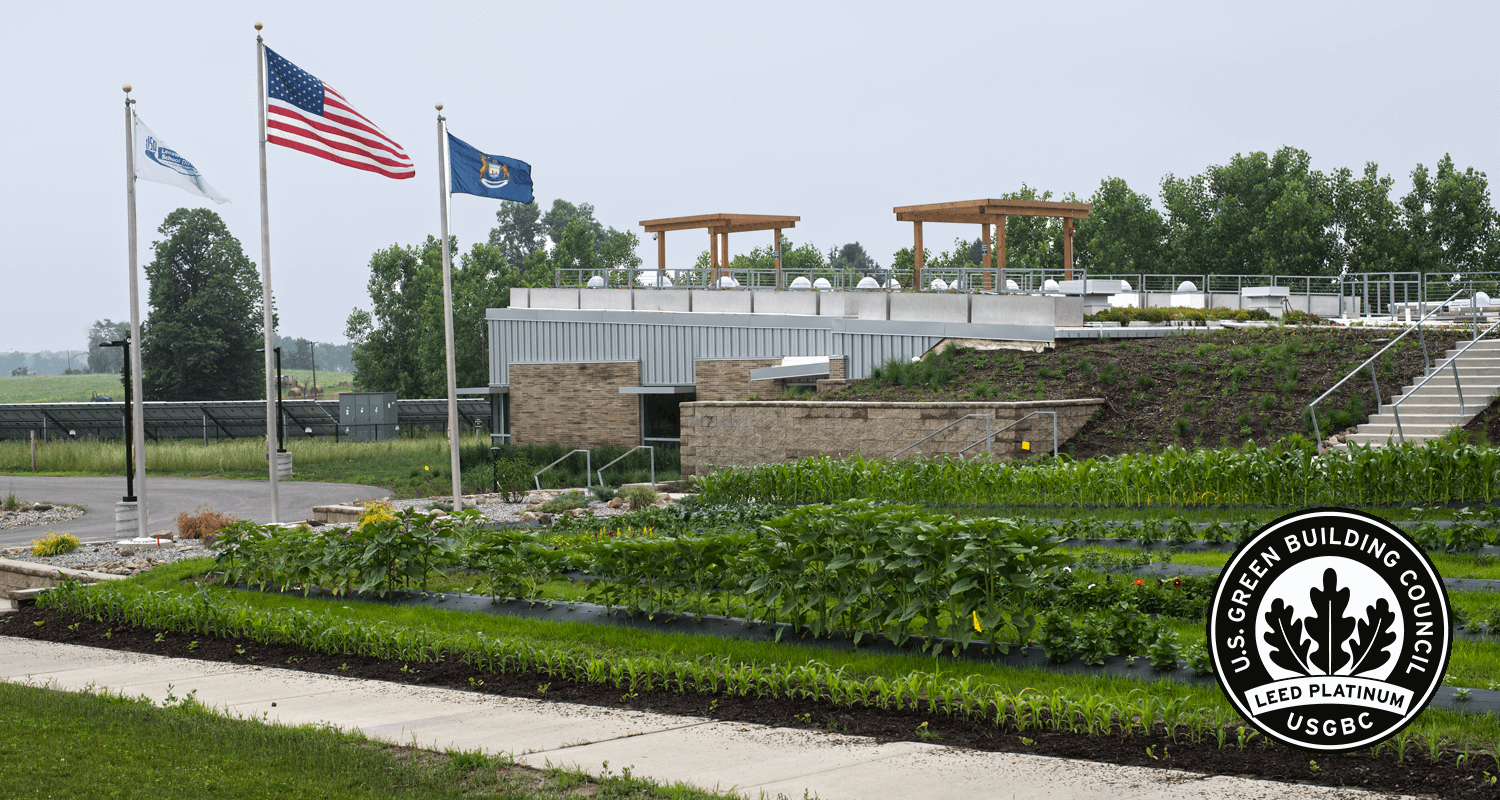Center for a Sustainable Future

As Michigan’s first net-zero energy, LEED Platinum certified school building, the Lenawee Intermediate School District’s (LISD) Center for a Sustainable Future (CSF) provides students of all ages with hands-on learning opportunities through product development, demonstration, and active research in the rapidly growing areas of sustainable agriculture and alternative energy production.
LISD CSF is home to 3 LISD TECH Center CTE student programs:
CSF Campus
75 acres of fields, forest, and wetlands
8,600 sq ft, net-zero energy school building
68 kW output of solar array
The SEED House
The SEED (Sustainable Energy-Efficient Demonstration) House is a state-of-the-art residential cut-a-way concept built on the LISD CSF Campus. This innovative and unique educational resource will embody proven building science and technologies highlighting new construction, remodeling, and energy retrofit approaches designed to promote healthy indoor air quality, comfort, and energy efficiency. The SEED House project is a partnership between the LISD and Midwest Energy Cooperative and will be open to the public in the near future.
LISD CSF Named a 2014 Green Ribbon School

In October 2014, Acting Chair of the White House Council on Environmental Quality, Mike Boots, joined U.S. Secretary of Education, Arne Duncan, to announce that the LISD Center for a Sustainable Future, in Adrian, Michigan, was among the 2014 U.S. Department of Education Green Ribbon Schools award honorees.
The LISD Center for a Sustainable Future (CSF) was nominated by the Michigan Department of Education for meeting the following Pillar accomplishments:
Pillar 1 - Reduced Environmental Impact and Costs
Pillar 2 - Improved Health and Wellness
Pillar 3 - Effective Environmental and Sustainability Education
Campus Goals
An Integrated Approach
Highlight overlaps and synergies between all of the proposed programs and design strategies that create strong relationships between these components, creating a dynamic, experiential landscape of learning for all who visit the site.
Contemporary Sustainable Agriculture/Agriscience Education
Provide building and site facilities where students, faculty, and the public can explore and experiment with emerging best practices in agri-sciences.
Ecological Restoration and Native Landscapes
Maximize restoration of native landscapes wherever possible, protect and restore existing important landscape such as the wetlands and the woodlot, integrate native landscape typologies into the central learning garden as a showcase for the public and as a zone for propagation and cultivation of native plants.
Environmental Education/Public Connectivity and Communication
Integrate environmental education and public access into all aspects of the site and program.
Landscape as Biological Infrastructure
Use functioning landscapes, such as biofilters and constructed wetlands to manage storm water run-off and wastewater on site in a legible manner that can be seen and understood by the public.
Campus Benefits and Details
The site is home to two structures, a maintenance/storage building and a greenhouse, which were constructed in 2001. The campus is also home to an 8,600 square foot, state-of-the-art, net-zero energy classroom building, which was completed in June, 2013.
Background
In March, 2011, the LISD Board of Education approved the campus master plan and feasibility study. In the summer of 2011, the LISD commissioned the services of the Collaborative, Inc., a Toledo architectural and engineering firm to design the new school building. In the spring of 2012, the Board of Education approved the design and authorized the letting of bids for construction. Bids were accepted and contracts authorized in June, 2012. In August of 2012, construction began on the new school building. Construction continued through June, 2013, when a ribbon cutting ceremony was held at the site.
Project Partners
The LISD Center for a Sustainable Future has benefited from the following donors:
- The DTE Energy Foundation
- The Consumers Energy Foundation
- The Robert Price Family Foundation
- Midwest Energy Cooperative
Sustainability
The LISD CSF models best practices for ecologically-responsible site and building design. Sustainable systems include a solar array, rain garden, demonstration plots, geothermal heating and cooling system, vegetative roof, and rainwater collection tank.
Curricular Impact: The diversity of ecosystems, large number of tillable acres, and farm equipment connects students to nature and real-world agriculture experience.
Site Orientation
The orientation of the school structure benefits from an earth berm, protecting it from north-westerly winter winds while opening to the passive solar opportunities facing south. Sun shades protect windows from the high angles of summer sun but allow winter sun angles to enter the building.
Water Conservation
The LISD CSF’s rainwater catchment system uses the rainwater collected from the school’s roof to irrigate demonstration plots and other plantings. Approximately 7,000 sq. ft. of roof area drains into a 10,000 gallon underground water storage tank. In times of low rainfall, the system is supplemented by the potable well water system.
All plumbing fixtures specified for this project are “low flow” fixtures. The CSF restrooms use approximately 45% less water than a typical restroom.
Curricular Impact: The water conservation systems provide students with experience collecting and reusing rainwater, experimenting with native plants to reduce soil erosion, and landscape designs to capture and recharge ground water supplies.
Building Envelope
The walls, roof, and floor of the building are insulated to values between two and three times that required by energy codes. Rigorous attention has been given to the continuity at roof-wall and wall-slab intersections, minimizing thermal bridging and air infiltration.
Precast concrete roof slabs, concrete block walls, and poured concrete slabs all within the insulation envelope of the building may help maintain an even temperature of the interior and buffer day-night heat cycles. Window systems are of low-infiltration, thermally-broken construction with high performance insulating glass. All building entries are provided with heat-lock vestibules.
Curricular Impact: The vegetative roof provides the opportunity for students to measure the temperature modulating affect and rainwater filtration ability of green roofs and to try out their own vegetative roof designs.
Solar Power
The LISD CSF has a 68kW photovoltaic generation system consisting of both ground and roof-mounted solar panels. The system generates all of the building’s electrical needs on an annual net-basis.
Heating & Cooling
The LISD CSF features a geothermal heating and cooling system which uses 400-foot deep wells to transfer heat to and from the ground in order to condition the building.
Temperatures are controlled by occupancy sensors in each classroom to minimize energy usage when spaces are unoccupied. The greenhouse and school vestibules feature radiant floor heating systems which use hot water piping embedded in the concrete floor.
Curricular Impact: The photovoltaic and geothermal systems provide students the experience of working with these increasingly common renewable energy systems. Real time data collection will inform instruction about alternative energy and green building techniques.
Natural Day Lighting
Solar tubes provide a balanced amount of daylight to the school’s interior. Each solar tube consists of a plastic dome that sits on the building’s roof and a reflective tube that carries the light inside. The tube that transports light is made of reflective material and can be bent to carry light to the space below.
Windows provide natural daylight, but because they are less efficient than other lighting methods used, they are primarily for outdoor views. The building uses all LED lighting fixtures which automatically dim to save energy when natural light is sufficient.
A Teaching Tool
As a net-zero energy school, the LISD CSF serves as an educational tool for LISD TECH Center programs and the Stubnitz Environmental Educational programs. Students gain real-world experience in managing, maintaining, and evaluating building automation systems.
For example, having all of the climate control components in one greenhouse provides a rare opportunity for students to work with the different systems under one roof and to conduct plant science experiments all year long – including how to grow food year round.
Students are introduced to sustainability concepts relevant to their programs: building healthy soil, conserving and protecting water, preserving biodiversity and food security, protecting human health and the environment. Students are encouraged to think critically about these options, carefully evaluating energy and agricultural practices.
Contact
LISD Center for a Sustainable Future
4260 Tipton Hwy, Adrian, MI 49221
517-263-2108



